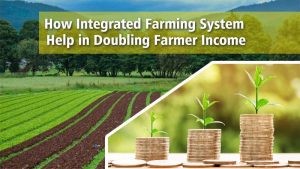What is regenerative agriculture?
Regenerative Agriculture is an approach to farming that emphasizes the regeneration and improvement of soil health, biodiversity, and ecosystem services, while also producing food, fiber, and other agricultural products. This approach aims to enhance the overall sustainability of agricultural systems, reduce negative environmental impacts, and improve the resilience and productivity of farms and landscapes. The Agriculture Scope of regenerative practices extends beyond traditional farming goals, prioritizing holistic ecosystem health and sustainable land management.
These practices typically involve a holistic and integrated approach to soil management, crop rotation, cover cropping, reduced tillage or no-till methods, and the use of diverse agroforestry and grazing systems. These practices focus on building organic matter, enhancing soil fertility and biological activity, improving water infiltration and retention, and reducing erosion and nutrient loss.
It also emphasizes the importance of preserving and enhancing natural ecosystems, promoting biodiversity, and using agroecological principles to manage pests and diseases. By adopting these practices, farmers and land managers can help mitigate climate change by sequestering carbon in soils and plants, while also improving the health and productivity of agricultural systems.
History of Regenerative Agriculture
The origins of regenerative agriculture can be traced back to the early 20th century when pioneering farmers like Sir Albert Howard, Rudolf Steiner, and J.I. Rodale began advocating for a more holistic approach to farming that emphasized the importance of soil health and the interconnectedness of the natural world.
In the 1940s and 1950s, the Green Revolution brought about a significant increase in crop yields through the use of synthetic fertilizers, pesticides, and mechanization. While this approach led to increased food production, it also had significant negative impacts on the environment, including soil erosion, water pollution, and loss of biodiversity.
In the 1970s and 1980s, a backlash against industrial agriculture began to emerge, with a growing movement of organic farmers and environmental activists advocating for more sustainable and regenerative farming practices. Organizations like the Rodale Institute and the Soil Association helped to promote these practices, and the term “regenerative agriculture” began to gain traction.
In the 1990s and 2000s, interest in regenerative agriculture continued to grow, driven in part by concerns about climate change and the need to find more sustainable and resilient farming methods. The development of new technologies, such as precision agriculture and agroecology, also helped to advance the field.
Principles of Regenerative Agriculture
The principles of Regenerative Agriculture can vary depending on the specific context and location, but here are some of the key principles:
Soil Health: The foundation of Regenerative Agriculture is healthy soil. The aim is to build soil organic matter and increase the microbial diversity of the soil, which leads to improved nutrient cycling, water-holding capacity, and soil structure. This is achieved through practices such as reducing tillage, keeping soil covered with cover crops or mulch, and integrating livestock into the system.
Biodiversity: It seeks to increase biodiversity on the farm. This includes planting diverse crops and cover crops, as well as encouraging the presence of beneficial insects, birds, and other wildlife. This can help to reduce pest pressure, improve soil health, and increase resilience to climate change.
Water Management: Water is a precious resource, and Regenerative Agriculture aims to manage it in a way that maximizes its use and reduces waste. This can be achieved through practices such as reducing soil erosion, increasing infiltration rates, and capturing and storing rainwater.
Holistic Management: Regenerative Agriculture takes a holistic approach to the farm, considering the farm as a whole system that includes not just the crops and animals, but also the soil, water, and other natural resources. This involves balancing economic, social, and ecological goals to create a resilient and sustainable system.
Carbon Sequestration: Regenerative Agriculture can play a role in mitigating climate change by sequestering carbon in the soil. By building healthy soil, plants can absorb and store more carbon dioxide from the atmosphere, reducing greenhouse gas emissions.
Community Engagement: Regenerative Agriculture can bring people together around a common goal of building a healthy and sustainable food system. This involves engaging with local communities and consumers, creating new markets for sustainably grown food, and building partnerships with other farmers and organizations.
Challenges in Regenerative Agriculture
While regenerative agriculture has the potential to address many of the environmental and social challenges associated with industrial agriculture, there are also several challenges that must be addressed in order to realize its full potential. Here are some of the key challenges:
Lack of access to information and education: Many farmers are not aware of the benefits of regenerative agriculture or how to implement regenerative practices on their farms. This can be due to a lack of access to information, resources, and education.
Limited funding and financial resources: Transitioning to regenerative agriculture can require significant investments in new equipment, infrastructure, and training. However, many farmers may not have access to the necessary financial resources to make these investments.
Regulatory barriers: Current regulatory frameworks may not support or incentivize regenerative agriculture practices, which can discourage farmers from adopting these practices.
Limited market demand: There may be limited market demand for regenerative agricultural products, which can make it difficult for farmers to sell their products at a premium price.
Limited research and data: There is still much to learn about the long-term benefits and impacts of regenerative agriculture. Researchers and practitioners need to conduct more research and gather additional data to enhance the understanding of the potential of regenerative agriculture in addressing environmental and social challenges.
Scaling up: While many small-scale farmers are already practicing regenerative agriculture, scaling up these practices to larger-scale operations can be challenging. Achieving this demands significant changes in current agricultural practices and necessitates increased collaboration across the agricultural industry.
Addressing these challenges will require a multi-faceted approach that involves policymakers, farmers, researchers, and consumers working together to create a more sustainable and regenerative food system.
Future and Scope of Regenerative Agriculture in India
The future and scope of regenerative agriculture in India are promising, given the country’s vast agricultural land and the need to increase productivity sustainably.
India is home to over 600 million farmers, making it one of the largest agricultural economies in the world. However, traditional agricultural practices in India often rely on the use of chemical fertilizers and pesticides, which can lead to soil degradation, loss of biodiversity, and environmental pollution. Regenerative agriculture offers a more sustainable and holistic approach to farming that can help address these issues.
The benefits of regenerative agriculture include increased soil health and fertility, reduced water use, improved crop resilience, and carbon sequestration. These benefits can lead to increased productivity, higher crop yields, and improved livelihoods for farmers. It also offers a way to mitigate climate change by reducing greenhouse gas emissions and promoting carbon sequestration.
In recent years, there has been a growing interest in regenerative agriculture in India, with a number of initiatives and organizations promoting the practice. The Indian government has also recognized the importance of regenerative agriculture and has included it in its National Action Plan on Climate Change.
The scope for regenerative agriculture in India is vast, with millions of hectares of agricultural land that can benefit from the practice. Nevertheless, farmers face challenges including limited awareness and knowledge, restricted access to resources and technology, and the necessity for policy and regulatory support.
To fully realize the scope of regenerative agriculture in India, there needs to be a concerted effort by all stakeholders, including farmers, policymakers, researchers, and civil society organizations. The future of regenerative agriculture in India is bright, and it offers a sustainable and holistic approach to farming that can benefit both the environment and society.
Get information related to tractors, tractor videos, and tractor games; and visit the Khetiguru mobile application for farming-related updates.



